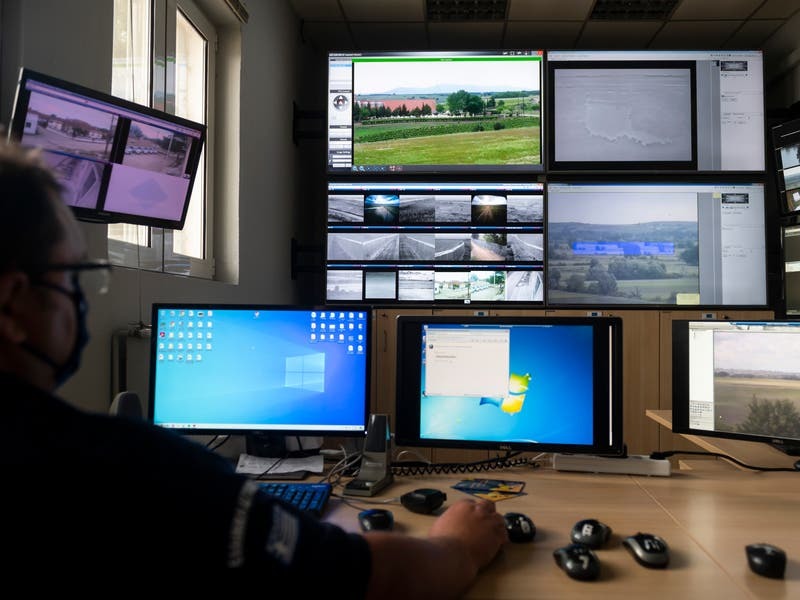The European Union is installing a high-tech surveillance system at a migration flashpoint along Greece’s border with Turkey during a lull in movement due to the coronavirus pandemic.
The artificial intelligence-powered monitoring network of cameras and sensors follows extensive testing of futuristic security controls such as automated lie detectors, virtual border guards and cameras that see through foliage.
Privacy advocates and human rights groups are calling for tougher oversight, worried that the technology will leave refugees stranded and will eventually be turned inward, to monitor European populations.
Among the physical and experimental new digital barriers being tested at the 125-mile Greek border with Turkey to stop people entering the EU illegally, Greek border police fire bursts of deafening noise from an armoured truck over the frontier into Turkey.

A new steel wall, similar to recent construction on the US-Mexico border, blocks commonly used crossing points along the Evros River that separates the two countries.
Nearby observation towers are being fitted with long-range cameras, night vision, and multiple sensors.
The data will be sent to control centres to flag suspicious movement using artificial intelligence analysis.
“We will have a clear ‘pre-border’ picture of what’s happening,” Police Major Dimonsthenis Kamargios, head of the region’s border guard authority, told the Associated Press.
The EU has poured three billion euros (£2.5 billion) into security tech research following the refugee crisis in 2015-16, when more than one million people – many escaping wars in Syria, Iraq and Afghanistan – fled to Greece and on to other EU countries.
The automated surveillance network being built on the Greek-Turkish border is aimed at detecting migrants early and deterring them from crossing, with river and land patrols using searchlights and long-range acoustic devices.

“Our task is to prevent migrants from entering the country illegally. We need modern equipment and tools to do that.”
Researchers at universities around Europe, working with private firms, have developed futuristic surveillance and verification technology, and tested more than a dozen projects at Greek borders.
AI-powered lie detectors and virtual border guard interview bots have been piloted, as well as efforts to integrate satellite data with footage from drones on land, air, sea and under water.
Palm scanners record the unique vein pattern in a person’s hand to use as a biometric identifier, and the makers of live camera reconstruction technology promise to erase foliage virtually, exposing people hiding near border areas.
Testing has also been conducted in Hungary, Latvia and elsewhere along the eastern EU perimeter.
The more aggressive migration strategy has been advanced by European policymakers over the past five years, funding deals with Mediterranean countries outside the bloc to hold migrants back and transforming the EU border protection agency, Frontex, from a co-ordination mechanism to a full-fledged multinational security force.

Earlier this month, several thousand migrants crossed from Morocco into the Spanish enclave of Ceuta in a single day, prompting Spain to deploy the army.
A similar crisis unfolded on the Greek-Turkish border and lasted three weeks last year.
Greece is pressing the EU to let Frontex patrol outside its territorial waters to stop migrants reaching Lesbos and other Greek islands, the most common route in Europe for illegal crossing in recent years.
Armed with new tech tools, European law enforcement authorities are leaning further outside borders.
Not all the surveillance programmes being tested will be included in the new detection system, but human rights groups say the emerging technology will make it even harder for refugees fleeing wars and extreme hardship to find safety.
Patrick Breyer, a European legislator from Germany, has taken an EU research authority to court, demanding that details of the AI-powered lie detection programme be made public.

He urged authorities to allow broad oversight of border surveillance methods to review ethical concerns and prevent the sale of the technology through private partners to authoritarian regimes outside the EU.
Ella Jakubowska, of the digital rights group EDRi, argued that EU officials were adopting “techno-solutionism” to sideline moral considerations in dealing with the complex issue of migration.
“It is deeply troubling that, time and again, EU funds are poured into expensive technologies which are used in ways that criminalise, experiment with and dehumanise people on the move,” she said.
Migration flows have slowed in many parts of Europe during the pandemic, interrupting an increase recorded over years.
In Greece, for example, the number of arrivals dropped from nearly 75,000 in 2019 to 15,700 in 2020, a 78% decrease.

Between 2000 and 2020, the world’s migrant population rose by more than 80% to reach 272 million, according to United Nations data, fast outpacing international population growth.
At the Greek border village of Poros, the breakfast discussion at a cafe was about the recent crisis on the Spanish-Moroccan border.
Many of the houses in the area are abandoned and in a gradual state of collapse, and life is adjusting to that reality.
Cows use the steel wall as a barrier for the wind and rest nearby.
Panagiotis Kyrgiannis, a Poros resident, says the wall and other preventive measures have brought migrant crossings to a dead stop.
“We are used to seeing them cross over and come through the village in groups of 80 or 100,” he said.
“We were not afraid… They don’t want to settle here. All of this that’s happening around us is not about us.”






